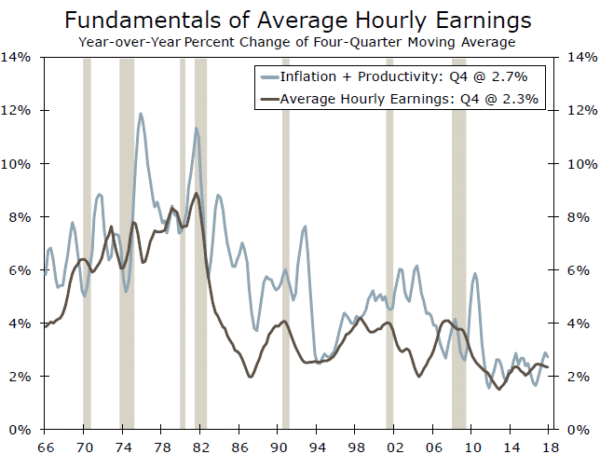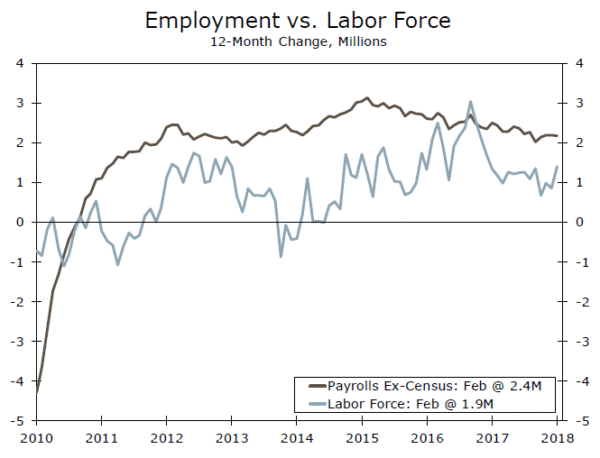Another month of job and wage gains support the case for better growth (2.5-3.0 percent) for 2018 and continued consumer spending. The long view remains for job gains to outpace labor force growth.
February Jobs at 313,000: Solid Sign for Income and Growth
Nonfarm payrolls rose 313,000 in February with the three-month average at a solid 242,000 jobs. Job gains are consistent with 2.5-3.0 percent economic growth in the first half of 2018, with steady consumer spending, better business investment and a likely FOMC March rate hike, soon followed by another one in June.
Jobs gains appeared in many sectors including business services, trade & transportation as well as education & health (top graph). Only information services jobs have declined in each of the past three months due to drops in jobs in telecommunications and motion pictures. Over the past three months, aggregate hours worked are up 3.1 percent – very solid and consistent with continued growth in personal income and consumption.
Inflation Leads Wages—Not Wages Lead Inflation
Contrary to the casual rhetoric, Granger causality tests reveal that inflation leads wages—not vice versa. This statistical result follows the theoretical model that workers and employers respond to higher inflation. Workers respond to inflation by trying to negotiate higher nominal wages to maintain a real wage standard. Employers find that higher inflation gives them the flexibility to raise wages and maintain profit margins.
Nominal average hourly earnings rose 0.15 percent in February and are up 2.6 percent over the year—slower than the January pace. While job growth remains strong, the gradual rise in earnings over the past six months signals higher incomes but also pressure on profits as firms have modest top-line pricing power. Longer term, subdued inflation readings and weak productivity numbers suggest limited gains in nominal wage growth.
The Long Game
Despite a strong labor force participation number in today’s report, the overall trend for labor force growth has slowed more recently, compared to 2014-2016 rates. In February, the labor force jumped 0.5 percent, month over month, but is up just 1.2 percent over the past year. The trend slowdown reflects the ongoing demographic shifts that run quietly in the background of the month to month changes in the labor market. Growth in the working age population (ages 16+) has slowed to 0.6 percent per year, less than half the pace registered in the 2000s. Excluding workers over the age of 65, population growth has stalled over the past year.
Rising labor force participation among prime-age workers has offered some support, but the participation rate for workers 25-54 remains more than a point and a half below its pre-recession level and almost two and a half points below the high set in 1999. Unless participation rates continue to rise as solidly as this month, we expect payroll growth to slow and the unemployment rate to decline over the course of the year as businesses have increasing difficulty finding workers.
















